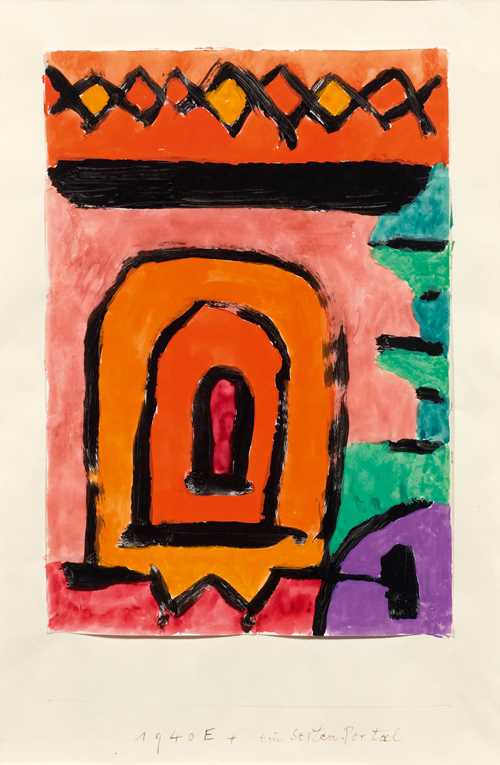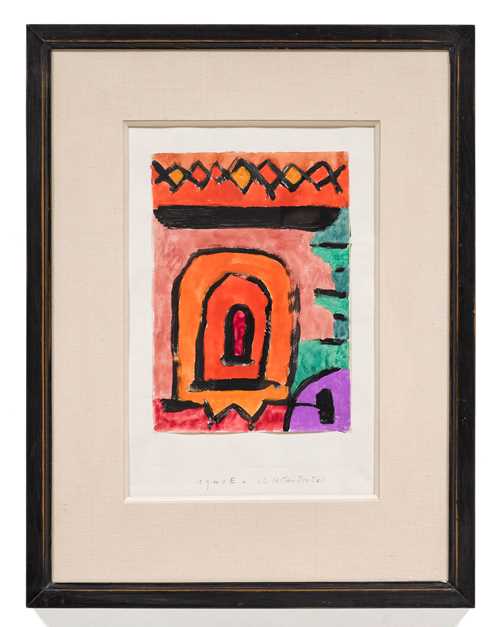
Lot 3233 - A199 Impressionist & Modern Art - Friday, 03. December 2021, 04.00 PM
PAUL KLEE
(Münchbuchensee 1879–1940 Muralto)
Ein Seiten-Portal. 1940.
Watercolour and coloured paste on paper on artist's board.
Dated, inscribed and titled lower centre on the artist's board: 1940. E 4 ein Seiten-Portal.
29 × 21 cm.
Provenance:
- Werner Allenbach, Bern, until 1957.
- Berggruen & Cie, Paris, 1957.
- Georges Moos collection, Geneva, presumably acquired from the above gallery.
- Swiss private collection, by descent from the above and owned by the family for three generations.
Exhibited:
Bern 1990, Paul Klee. Das Schaffen im Todesjahr, Kunstmuseum Bern, 17.8.–4.11.1990, no. 326 (with col. ill. p. 252).
Literature:
Paul-Klee-Stiftung and Kunstmuseum Bern (eds.): Catalogue raisonné Paul Klee, vol. 6 (1913–1918), Bern 2000, no. 5657 (with ill.).
The present watercolour from 1940, the year the artist passed away, is a testimony to the exuberant creative work that Klee achieved shortly before his death. Since the early days of his career, Klee had been inspired to explore architectural forms, one of his main interests during his six-month study trip to Italy with his friend, the sculptor Hermann Haller. This return to the existential, fundamental questions of his art, proportion and colour, reveals the uniqueness of this work in several respects. In addition to its thematic significance, a world-historical and biographical dimension also presents itself, in which the portal reflects a stage of transition in the artist's last months, in both this world and the hereafter, and can also be symbolically associated with the outbreak of war in Europe.
The catalogue raisonné lists 1253 works in the year 1939, a numerical high point, which together with 366 works in 1940 bespeaks an astoundingly prolific period. While in February 1940 an exhibition was held at the Kunsthaus Zürich on the occasion of his 60th birthday, the only exhibition of his late work planned by him, a race against time took place during the last months of his life. Due to his illness, he began the most productive phase of his creative output in line with his motto “nulla dies sine linea”, a formula that, in view of the symbolic number 366, the artist held up to the end. As early as September 1939, Klee responded to the level of his excessive creative output by specifying months in the catalogue of works. He additionally organised his works with a new system, which he provided with a letter (starting backwards from Z) before the code number. The race ended with the letter E and the number 366. The present work with the number E 4 is thus the third last in Klee's own catalogue of works. Paul Klee died on June 29, 1940 in a clinic in Muralto-Locarno.
- Werner Allenbach, Bern, until 1957.
- Berggruen & Cie, Paris, 1957.
- Georges Moos collection, Geneva, presumably acquired from the above gallery.
- Swiss private collection, by descent from the above and owned by the family for three generations.
Exhibited:
Bern 1990, Paul Klee. Das Schaffen im Todesjahr, Kunstmuseum Bern, 17.8.–4.11.1990, no. 326 (with col. ill. p. 252).
Literature:
Paul-Klee-Stiftung and Kunstmuseum Bern (eds.): Catalogue raisonné Paul Klee, vol. 6 (1913–1918), Bern 2000, no. 5657 (with ill.).
The present watercolour from 1940, the year the artist passed away, is a testimony to the exuberant creative work that Klee achieved shortly before his death. Since the early days of his career, Klee had been inspired to explore architectural forms, one of his main interests during his six-month study trip to Italy with his friend, the sculptor Hermann Haller. This return to the existential, fundamental questions of his art, proportion and colour, reveals the uniqueness of this work in several respects. In addition to its thematic significance, a world-historical and biographical dimension also presents itself, in which the portal reflects a stage of transition in the artist's last months, in both this world and the hereafter, and can also be symbolically associated with the outbreak of war in Europe.
The catalogue raisonné lists 1253 works in the year 1939, a numerical high point, which together with 366 works in 1940 bespeaks an astoundingly prolific period. While in February 1940 an exhibition was held at the Kunsthaus Zürich on the occasion of his 60th birthday, the only exhibition of his late work planned by him, a race against time took place during the last months of his life. Due to his illness, he began the most productive phase of his creative output in line with his motto “nulla dies sine linea”, a formula that, in view of the symbolic number 366, the artist held up to the end. As early as September 1939, Klee responded to the level of his excessive creative output by specifying months in the catalogue of works. He additionally organised his works with a new system, which he provided with a letter (starting backwards from Z) before the code number. The race ended with the letter E and the number 366. The present work with the number E 4 is thus the third last in Klee's own catalogue of works. Paul Klee died on June 29, 1940 in a clinic in Muralto-Locarno.
CHF 160 000 / 240 000 | (€ 164 950 / 247 420)
Sold for CHF 305 300 (including buyer’s premium)
All information is subject to change.


